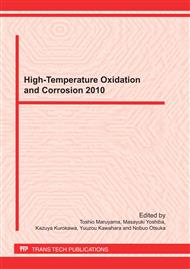[1]
H.J. Grabke, M. Schütze (Eds. ): Oxidation of intermetallics (Wiley-VCH, Weinheim, 1997).
Google Scholar
[2]
U. Koops, D. Hesse and M. Martin: J. Mater. Res. Vol. 17 (2002), p.2489.
Google Scholar
[3]
E. Ryshkewitch, D.W. Richerson: Oxide Ceramics (Academic, Orlando, 1985).
Google Scholar
[4]
A. Hammou, J. Guindet, in: The CRC Handbook of Solid State Electrochemistry, edited by P.J. Gellings, H.J.M. Bouwmeester, CRC Press, Boca Raton (1996), p.407.
DOI: 10.1016/s0022-0728(99)00081-9
Google Scholar
[5]
J. Sunarso, S. Baumann, J.M. Serra, W.A. Meulenberg, S. Liu, Y.S. Lin and J.C. Diniz da Costa: Journal of Membrane Science Vol. 320 (2008), p.13.
DOI: 10.1016/j.memsci.2008.03.074
Google Scholar
[6]
M. Martin: J. Chem. Thermodynamics Vol. 35 (2003), p.1291.
Google Scholar
[7]
D.N. Mueller, R.A. De Souza, T.E. Weirich, D. Roehrens, J. Mayer and M. Martin: Phys. Chem. Chem. Phys. Vol. 12 (2010), p.10320.
Google Scholar
[8]
S.R. de Groot, P. Mazur: Non-Equilibrium Thermodynamics (North-Holland, Amsterdam 1962).
Google Scholar
[9]
H. Schmalzried, W. Laqua and P.L. Lin: Z. Naturforsch. Vol. 34a (1979), p.192.
Google Scholar
[10]
O. Teller, M. Martin: Solid State Ionics Vol. 101-103 (1997), p.475.
Google Scholar
[11]
O. Teller, M. Martin: Ber. Bunsenges. Phys. Chem. Vol. 101 (1997), p.1377.
Google Scholar
[12]
O. Teller, M. Martin: Electrochemistry Vol. 68, (2000), p.294.
Google Scholar
[13]
H. Schmalzried, W. Laqua: Oxid. Metals Vol. 15 (1981), p.339.
Google Scholar
[14]
U. Brinkmann, W. Laqua: Phys. Chem. Minerals Vol. 12 (1985), p.283.
Google Scholar
[15]
C. Wagner: Z. Phys. Chem. B Vol. 21 (1933), p.25.
Google Scholar
[16]
P. Kofstad: High temperature corrosion (Elsevier, London, 1988).
Google Scholar
[17]
G.J. Yurek, J.P. Hirth and R.A. Rapp: Oxidation of Metals Vol. 8 (1974), p.265.
Google Scholar
[18]
H.S. Hsu: Oxidation of Metals Vol. 26 (1986), p.315.
Google Scholar
[19]
U. Koops, M. Martin: Z. Anorg. Allg. Chem. Vol. 629 (2003), p.1688.
Google Scholar
[20]
M. Martin, U. Koops and N. Lakshmi: Solid State Ionics Vol. 172 (2004), p.357.
Google Scholar
[21]
M. Martin, N. Lakshmi, U. Koops and H. -I. Yoo: Z. Phys. Chem. Vol. 221 (2007), p.1499.
Google Scholar
[22]
H.S. Hsu, G.J. Yurek: Oxidation of Metals Vol. 17 (1982), p.55.
Google Scholar
[23]
J. Paidassi, M. Vallée and P. Pépin: Mem. Sci. Rev. Metall Vol. 62 (1965), p.857.
Google Scholar


